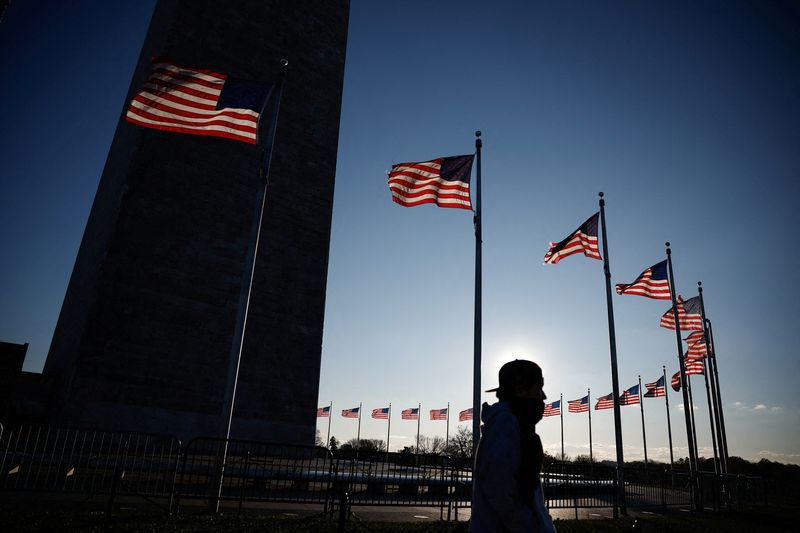By Lucia Mutikani
WASHINGTON (Reuters) – U.S. job growth likely surged in November after being severely constrained by hurricanes and strikes, but this probably does not signal a material shift in easing labor market conditions that should allow the Federal Reserve to cut interest rates again this month.
Economists suggested averaging last month’s nonfarm payrolls gains with October’s count to get a clearer trend of job growth when the Labor Department’s closely watched employment report is released on Friday. Job growth almost stalled in October as the labor market reeled from Hurricanes Helene and Milton as well as a big strike at Boeing (NYSE:BA) factories in the West Coast.
“We do not think that a surge in November job gains implies a sudden resurgence in hiring, but only the normalization from temporary shocks in the data,” said Oscar Munoz, chief U.S. macro strategist at TD Securities. “It would be more unbiased to analyze the recent payrolls performance by looking at the
October-November data together.”
Nonfarm payrolls probably increased by 200,000 jobs last month, a Reuters survey of economists showed. Estimates ranged from 155,000-275,000 jobs. The economy added a paltry 12,000 jobs in October, the smallest gain since December 2020.
Based on the November estimate, job growth would be trending around 145,000 over the past three months, which economists said was consistent with a healthy but slowing labor market.
Employment growth in October was also likely curtailed by a shorter collection period of responses to the survey of establishments from which payrolls are derived. The response rate for the establishment survey was 47.4%, the lowest since January 1991 and well below the 69.2% average for October in the past five years. The collection period for the responses was only 10 days, on the lower end of the normal 10-16 days.
Economists believe October payrolls will be revised higher.
Returning Boeing factory workers and those from another smaller aerospace company are expected to add about 38,000 jobs to payrolls in November. A post-storm rebound of around 60,000-65,000 jobs is anticipated.
“The payroll-survey collection rate was well below average in October, which has been associated with larger-than-normal absolute revisions,” said Andrew Husby, a senior economist at BNP Paribas (OTC:BNPQY) Securities. “History also shows that initial estimates can overstate the drag from storms.”
RISING UNEMPLOYMENT RATE
The unemployment rate was forecast climbing to 4.2% after holding at 4.1% for two straight months.
The anticipated increase in the jobless rate was seen driven by a snap back in labor supply after declining in October, blamed on people being displaced by the hurricanes.
Wage growth was estimated to have cooled after rising solidly in October, likely as the storms kept hourly paid employees at home. Average hourly wages are forecast increasing by 0.3% after rising 0.4% in October. That would lower the annual increase in wages to 3.9% from 4.0% in October.
“Given all of the noise in the labor market data over the past few months, Fed officials are not likely to view the last two months’ readings at face value,” said Stephen Stanley, chief U.S. economist at Santander (BME:SAN) U.S. Capital Markets. “A number of policymakers have spoken over the past few weeks, and there is near unanimity that the labor market is cooling but healthy.”
Financial markets saw a roughly 70% chance of a 25 basis points rate cut at the U.S. central bank’s Dec. 17-18 policy meeting, CME’s FedWatch tool showed.
The Fed has lowered interest rates by 75 basis points since September, when it launched its easing cycle. Its policy rate is now in the 4.50%-4.75% range. It was hiked by 5.25 percentage points between March 2022 and July 2023.
With the economy continuing to expand at a healthy pace, inflation stuck above the central bank’s 2% target and policy uncertainty from President-elect Donald Trump’s incoming administration, the outlook for rate cuts in 2025 is unclear.
Business sentiment perked up in the aftermath of Trump’s victory on hopes of fewer regulations, but his promises to raise tariffs on imports and carry out mass deportations have raised concerns of higher prices and disruptions to the labor market.
“Considering the elections results, we now assume a rate cut at every other meeting in 2025, for a total of 100 basis points of easing, down from 150 basis points previously,” said Lydia Boussour, senior economist at EY-Parthenon.

